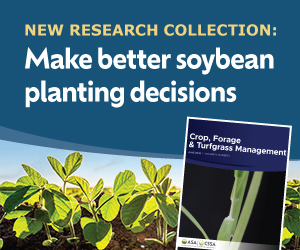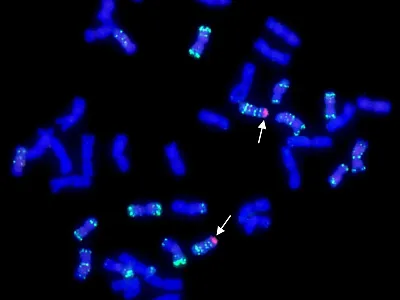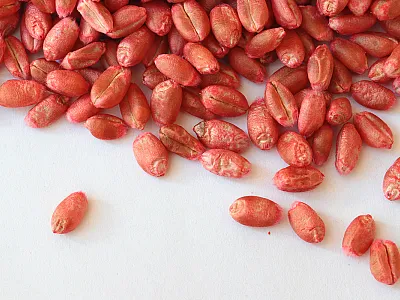Nitrogen management for hybrid canola in Canada
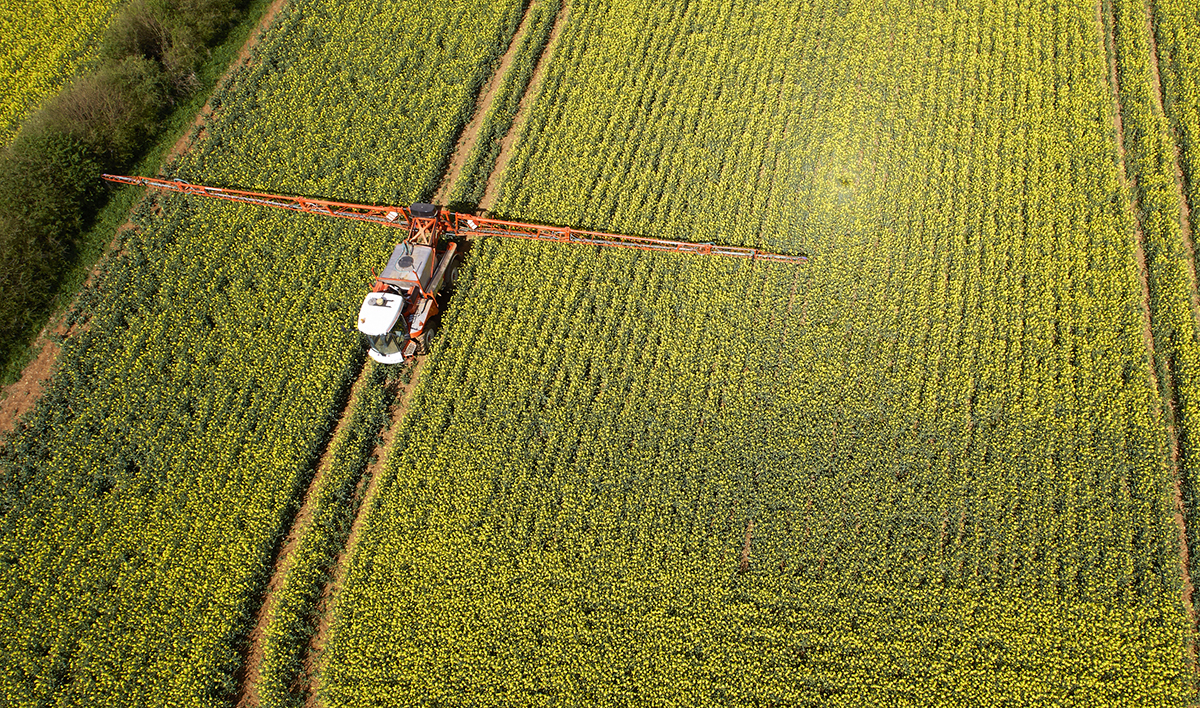

High-yielding hybrid canola cultivars are grown widely across Canada, demanding higher nitrogen (N) inputs to support increased yields with high seed oil and protein content. While the improved N use efficiency of modern cultivars suggests high yields are achievable with less fertilizer supplies, the yield potential and N uptake efficiency of new canola hybrids are highly dependent on soil nutrient status and weather conditions, and these factors are difficult to assess before N application. These uncertainties complicate the precise N management practices for hybrid canola. In this study, we examined the yield response of a range of hybrid canola cultivars to N fertilization from 50 site-year field trials across Canada. We also evaluated the benefits of a split-N application strategy under both abundant and limited precipitation conditions. Based on these findings, AI models were developed to enable site-specific N recommendations.
Earn 1 CEU in Nutrient Management by reading this article and taking the quiz.
Hybrid canola cultivars were first introduced in 1989 and are widely grown in Canada due to their high yield potential and improved N use efficiency. For example, in trials at Scott, Melfort, and Indian Head, Saskatchewan, canola hybrid InVigor 2663 produced 16.5% higher yields than the open-pollinated cultivar Quantum at the same 134 lb N/ac application rate (Mahli et al., 2007). This high-yielding characteristic requires substantial N input to support vigorous crop growth and enhance oil and protein accumulation (Ma et al., 2015; Ma & Herath, 2016), which can mask improvements in N use efficiency achieved from advanced hybrid breeding, thereby increasing environmental risks and carbon footprint (Ma et al., 2023). Because hybrids are constantly being updated every three to five years and N management guidance for modern hybrid canola is limited, a thorough understanding of its yield response to N supply is critical. This knowledge empowers producers to optimize fertilization while improving crop productivity and environmental stewardship goals.
As a cool-season crop, canola is highly sensitive to heat and drought stress. Reduced precipitation limits root growth, and heat stress coupled with drought reduces stomatal conductance and photosynthesis, minimizing the formation of yield components such as silique number and seed weight, ultimately affecting crop productivity and quality (Biswas et al., 2019; Wu et al., 2018). Moreover, N fertilizers are typically applied before planting or before the crop begins to actively grow—a stage at which these physiological and metabolic responses have yet occurred (Ma et al., 2015, 2020; Ma & Zheng, 2016). These uncertainties make providing accurate and effective N recommendations particularly challenging.
To address these scientific and practical challenges, this study aims to investigate the response of new hybrid canola cultivars to N fertilization in diverse Canadian agroecosystems; and to introduce an AI-powered tool designed to deliver site-specific N recommendations early in the growing season.
To achieve these objectives, field experiments were carried out from 2013 to 2022 at 50 sites-years across Canada (Figure 1). At each site-year, a factorial experiment with two hybrids and eight N treatment combinations was arranged in a randomized complete block design with four replications. Canola hybrids and N treatments used in this study are listed in Table 1.
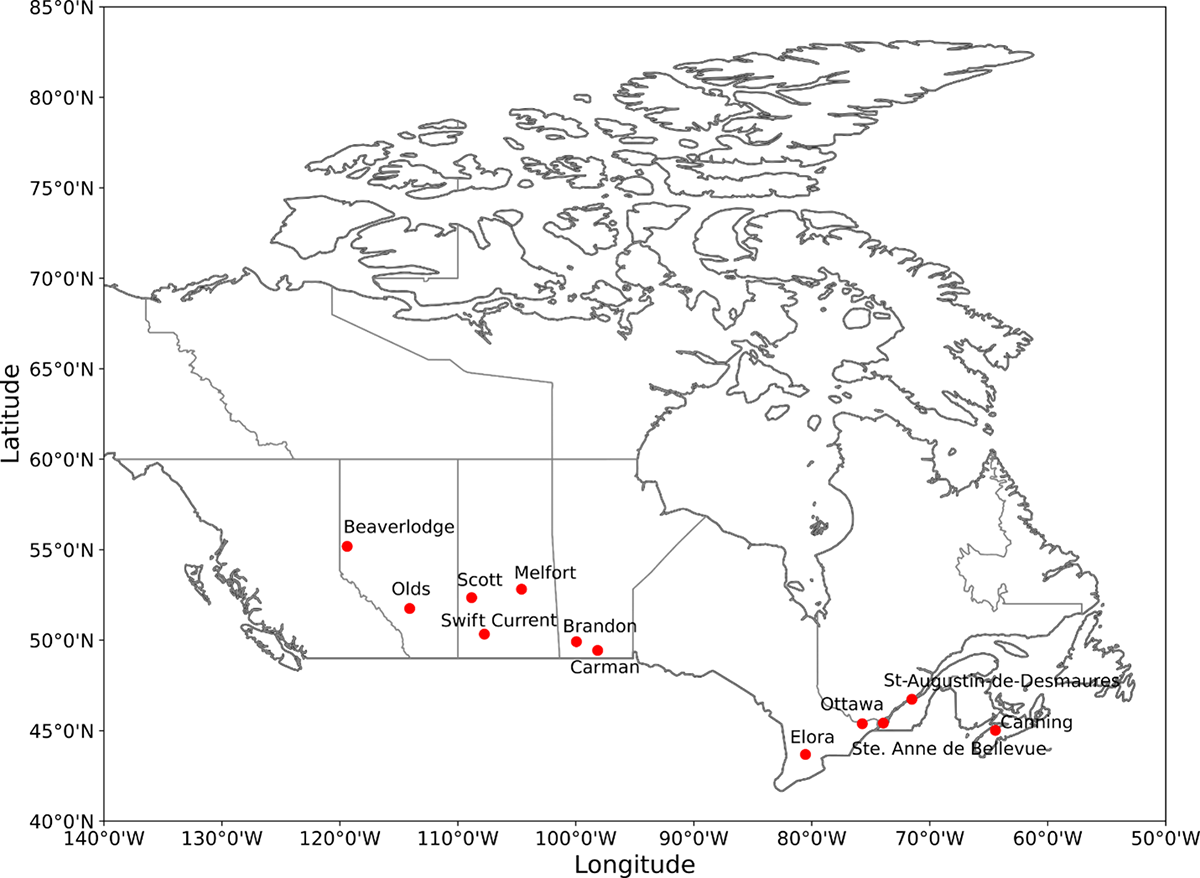
| Regions | Sites | Canola hybrids | Soil organic matter (% of dry soil) | N treatments |
|---|---|---|---|---|
Eastern Canada | Ottawa, ON | InVigor 5440, InVigor L150, InVigor L140P, InVigor L233P, InVigor L252 | 2.3–4.1 | N applied at planting: 0, 45, 89, 134, and 179 lb N/ac; N split application: 45 lb N/ac at planting plus 45, 89, and 134 lb N/ac at four- to six-leaf stage |
| Ste. Anne de Bellevue, QC | InVigor L140P, InVigor 5440, InVigor L150 | 5.9–6.3 | ||
| St-Augustin-de-Desmaures, QC | 2.8–6.3 | |||
| Elora, ON | 2.5–3.8 | |||
| Canning, NS | InVigor L233P, InVigor L252 | 2.7–3.1 | ||
Western Canada | Beaverlodge, AB | 6074RR, PV581GC | 3.7–7.4 | |
| Olds, AB | 7.7–8.1 | |||
| Scott, SK | PV533G, PV581GC | 2.6–3.0 | ||
| Melfort, SK | 8.6–10.0 | |||
| Brandon, MB | InVigor L233P, InVigor L252 | 2.5–5.0 | ||
| Carman, MB | 2.6–3.1 | |||
| Swift Current, SK | InVigor L233P, InVigor L255PC | 2.2–2.5 |
Note: Hybrid cultivars varied by location and growing season. For both the single N treatment and the initial application of 45 lb N/ac in the split-N treatment, fertilizer was broadcast and incorporated into the soil at planting. For split-N application, the remaining N was topdressed manually at the four- to six-leaf stage.
Soil properties, including organic matter, pH and cation exchange capacity at preplant, and soil mineral N both before planting and after harvest were measured to determine their impact on crop production. Plant health and N status were monitored using a SPAD-502 leaf chlorophyll meter and canopy reflectance (expressed as Normalized Difference Vegetation Index; NDVI) with GreenSeeker (Wu et al., 2022). Canola yields were recorded at harvest, and N use efficiency (lb seed /lb N input) was calculated:

Yield responses to nitrogen fertilizer application generally follow a quadratic pattern. Therefore, EONR is calculated following the procedure shown in Figure 2.
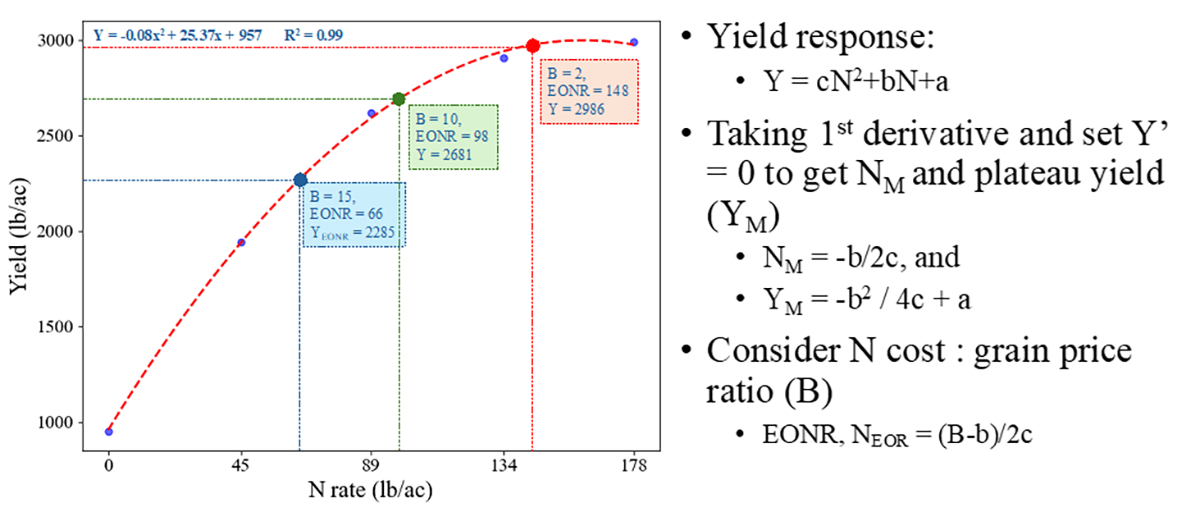
Using field soil data, plant health, and weather data, we developed machine-learning models, including support vector machine and random forest. Implemented with scikit-learn, the models were optimized via grid search with tenfold cross-validation and evaluated using leave-one-out cross-validation, focusing on Pearson correlation as a key performance metric (Wen et al., 2021; 2022).
Nitrogen management
Yield–nitrogen response
The yield response of hybrid canola to N supply is strongly influenced by growing season weather conditions. With adequate and evenly distributed rainfall, canola yield increased significantly by an average of 35% at N application rates from 0 to the EONR with estimated EONR canola yields meeting or exceeding the 52 bu/ac benchmark set by the Canola Council of Canada. In contrast, in regions with limited and erratic rainfall distribution, such as Swift Current, SK, canola yields were consistently lower, regardless of N application (Figure 3).
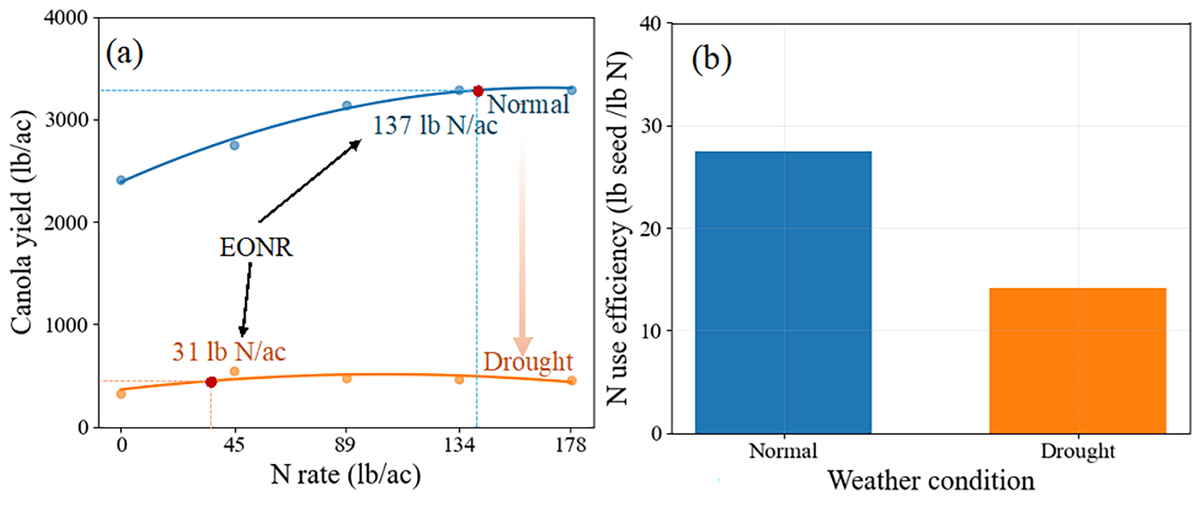
In this study, more than 40% of the studied sites-years experienced some degree of moderate to severe drought stress (total growing season rainfall <85% of the 30-year average). Interestingly, fields with high soil organic matter (SOM), such as those in Melfort (SK), Beaverlodge (AB), and Odds (AB), were able to buffer against mild to moderate drought stress and still increase yields with increased N input. This resilience is likely due to the soil’s superior water-holding capacity (Ma et al., 2015, 2020; Wen et al., 2023). However, under severe and extreme drought conditions, neither high SOM nor increased N application can prevent yield losses—canola yields may drop by up to 80% compared with those under optimal conditions (Wen et al., 2022, 2023). This occurs because dry soil restricts root growth and limits nutrient uptake (Wu et al., 2018), which in turn slows or even stops key physiological processes such as photosynthesis (Biswas et al., 2019), reducing plant pod and seed development (Figure 4; Wen & Ma, 2024).

Under high-yielding conditions, hybrid canola requires more N than open-pollinated cultivars to support greater biomass production and higher seed oil and protein content. An earlier two-year field study in Melfort, SK (also a trial site for our study) showed that hybrid cultivars produced significantly higher yields than the open-pollinated cultivar at similar N rates (Mahli et al., 2007). In our study, despite higher N requirements, all hybrids showed impressive N use efficiency when N was applied at economic optimum nitrogen rate (EONR) levels, producing 28 lb of seed per pound of N applied over 22 normal site-year environments (Figure 3b). Compared with earlier findings at the same site by Mahli et al. (2007), whose open-pollinated cultivar produced approximately 18 lb of seed for each lb of N applied. However, we also note that under low precipitation conditions, small amounts of single N application at planting combined with soil residual N and in-season mineralization may be sufficient to meet crop needs. In this case, the N use efficiency of the tested hybrids dropped sharply, producing only 2–16 lb of seed per lb of N fertilizer applied, as evidenced by 20 site-year trials. This highlights the risk of over-application of N in dry conditions, which can lead to increased losses and greater environmental impacts.
Split-N application
The mismatch between soil N supply and crop growth curves is a key cause of low N use efficiency, as crops are unable to effectively absorb soil available N relative to their needs (Bijay-Singh et al., 2024). For example, a single preplant application of N can create a large mineral N pool in the soil, resulting in a high risk of N loss through N2O emissions, NH3 volatilization and NO3- leaching (Ma et al., 2010). This is because in the early stages of vegetative growth, canola crops grow slowly, and it takes 4-6 weeks after emergence for the crop roots to quickly absorb N (Ma and Zheng, 2016).
Split N application—dividing total N into a small initial dose and a second dose during the rapid growth phase of the crop—offers a promising strategy for reducing the risk of overfertilization and crop lodging (Wu & Ma, 2022; Wu et al., 2022) and matching crop growth and N uptake curves (Ma & Zheng, 2016), especially during seasons when drought or unpredictable weather is expected. The main advantage of this strategy is the flexibility to adjust topdressing according to in-season conditions. For example, under normal weather conditions (Figure 5a), such as at Beaverlodge in 2018, a split-N strategy increased canola yield by an average of 5% in 38 cases across 50 site-year environments compared with the single-N strategy at the same N rate. In comparison, Swift Current's two-year average EONR was only 31 lb N/ac (Figure 3a), meaning that an application of 45 lb N/ac at planting was sufficient to meet crop growth requirements without the need for additional topdressing.
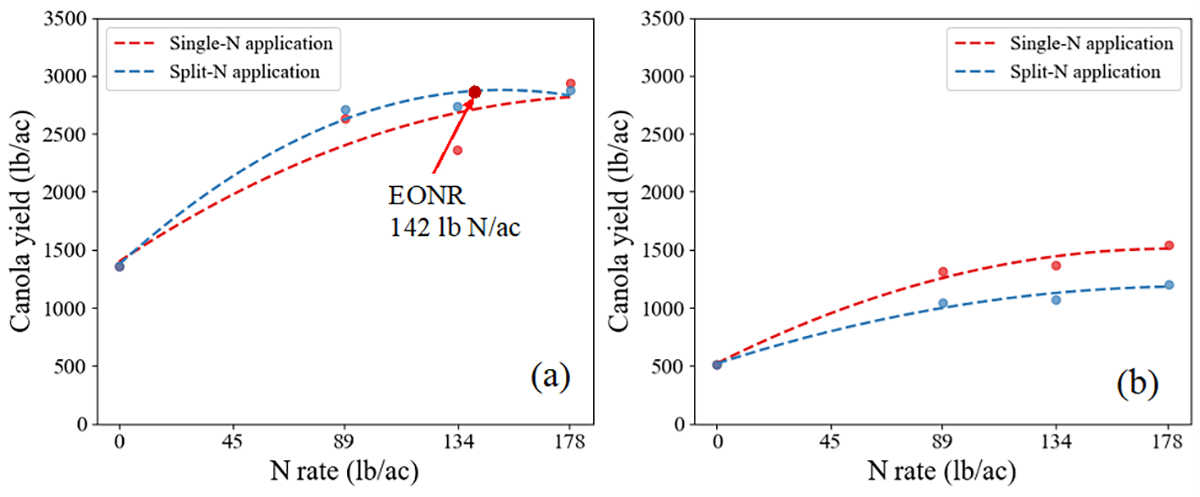
This strategy can also benefit producers by saving on N input costs and provide the public with clean air by preventing N loss into the environment, thus contributing to a sustainable environment. However, exceptions did occur during dry or unevenly distributed rainfall seasons, such as at Melfort in 2019 where the split-N strategy resulted in slightly lower yields and lower N use efficiency in 8 out of the 50 site-year environments (Figure 5b). This may be due to excessive early-season rainfall leading to N leaching from the root zone as well as the initial application rate of 45 lb N/ac being insufficient to support vigorous early crop growth. Nitrogen deficiency at the vegetative stage can limit root development, weakening the plant's resilience to mid-season drought (Ma and Zheng, 2016). Drought after topdressing limits the availability of in-season applied N and may result in reduced crop N utilization.
Currently, adoption of split-N application strategy among Canadian canola producers is low with only about 5% of farms using this strategy according to the Canadian 2023 Fertilizer Use Survey (Fertilizer Canada, 2023). This strategy is highly adaptable, allowing initial dosage to be fine-tuned to meet early growth needs while retaining the option of topdressing based on real-time weather patterns. During early-season drought conditions, initial N applications can be reduced, and if conditions improve later, supplemental N fertilizer can be applied to support continued growth, thus striking a balance between economic input, crop productivity, and environmental responsibility.
Nitrogen management tool
These findings highlight the need to tailor N application to site-specific conditions to achieve sustainable canola production. With its powerful predictive capacities, artificial intelligence (AI) is increasingly used in agriculture and shows great potential to provide precise early-season N recommendations (Wen & Ma, 2024). In this study, we developed AI models using historical weather (e.g., past 10 years of precipitation), soil, field management (fertilizer rate, preceding crop, etc.), and crop growth data (leaf chlorophyll content and NDVI) to predict site-specific EONR for hybrid canola (Wen et al., 2021, 2022). Among the models tested, random forest performed best with an R² of 0.90 and a relative error of 2% compared with the EONR value calculated from the yield–N response curve (Figure 6). This shows that the AI-based model effectively classified seasonal rainfall and adjusted N recommendations accordingly, especially under moderate to favorable rainfall conditions.
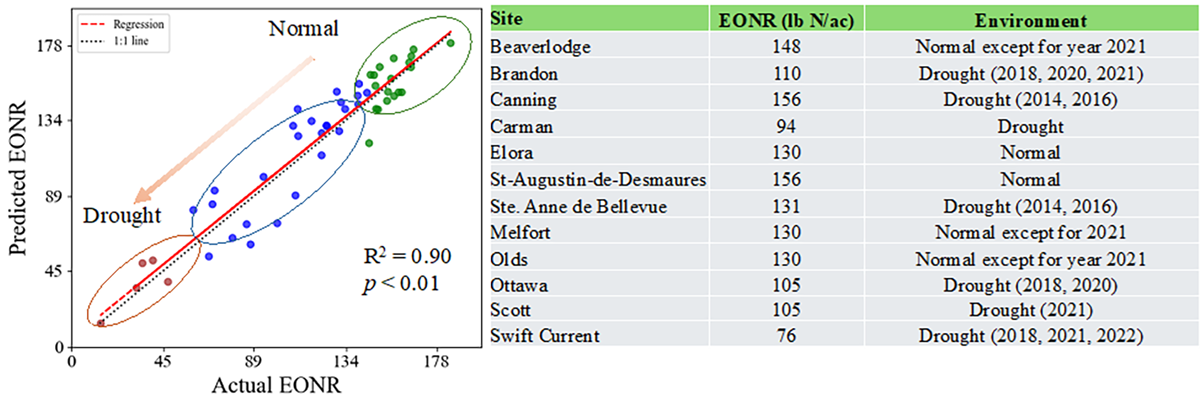
The tool, still under development, is expected to incorporate soil mineral N, soil moisture, cation exchange capacity, and soil conductivity, etc. into dynamic models based on deep learning. The integration of AI models with split-N application strategies is expected to support early informed decision-making to increase yield and reduce environmental impact, thereby advancing precise, sustainable N management for hybrid canola.
In conclusion, this multi-site-year study shows that the EONR for hybrid canola varies significantly depending on prevailing weather, soils, and agroecosystems with different rainfall patterns. Based on random forest model predictions, an EONR of 130–150 lb N/ac is recommended for Canadian prairie black soil zones, reflecting higher yield potential and higher SOM. In contrast, low-yielding brown soil zones, which are more prone to drought and have lower SOM, require a lower EONR of 75–90 lb N/ac. Transitional soil zones, such as the brown–black junction areas, and regions like Ontario typically require about 107–134 lb N/ac. The AI-enhanced dynamic model enables canola producers to make real-time adjustments based on early-season weather, soil, and crop-growing conditions, employing split-N fertilizer strategies and fine-tuning actual application rates to optimize crop yields, enhance production efficiency and profitability while minimizing environmental impact.
Bijay‑Singh, B., Buresh, R.J., & Peng, S. (2024). Synchronising nitrogen fertiliser application to crop nitrogen needs. In J.K. Ladha (Ed.), Improving nitrogen use efficiency in crop production (pp. 167–200). Burleigh Dodds Science Publishing.
Biswas, D.K., Ma, B.L., & Morrison, M.J. (2019). Changes in leaf nitrogen and phosphorus content, photosynthesis, respiration, growth, and resource use efficiency of a rapeseed cultivar as affected by drought and high temperatures. Canadian Journal of Plant Science, 99, 488–498. https://doi.org/10.1139/cjps-2018-0023
Fertilizer Canada. (2023). 4R in Canada: A national overview. 2023 Fertilizer use survey. Retrieved from https://fertilizercanada.ca/wp-content/uploads/2025/04/Fertilizer-Use-Survey-2023-Report.pdf
Ma, B.L., Biswas, D.K., Herath, A.W., Whalen, J.K., Ruan, S.Q., Caldwell, C., Earl, H., Vanasse, A., Scott, P., & Smith, D.L. (2015). Growth, yield and yield components of canola as affected by nitrogen, sulphur and boron fertilization. Journal of Plant Nutrition and Soil Science, 178, 658–670. https://doi.org/10.1002/jpln.201400280
Ma, B.L., & Herath, A.W. (2016). Timing and rates of nitrogen fertiliser application on seed yield, quality and nitrogen-use efficiency of canola. Crop and Pasture Science, 67, 167–180. https://doi.org/10.1071/CP15069
Ma, B.L., Liang, C., Herath, A., Caldwell, C.D., & Smith, D.L. (2023). Canola productivity and carbon footprint under different cropping systems in eastern Canada. Nutrient Cycling in Agroecosystems, 127, 191–207. https://doi.org/10.1007/s10705-023-10294-w
Ma, B.L., Wu, T.Y., Tremblay, N., Deen, W., McLaughlin, N.B., Morrison, M.J., & Stewart, G. (2010). On‑farm assessment of the amount and timing of nitrogen fertilizer on ammonia volatilization. Agronomy Journal, 102, 134–144. https://doi.org/10.2134/agronj2009.0021
Ma, B.L., & Zheng, Z.M. (2016). Relationship between plant nitrogen and phosphorus accumulations in a canola crop as affected by nitrogen management under ample phosphorus supply conditions. Canadian Journal of Plant Science, 96, 853–866. https://doi.org/10.1139/cjps-2015-0374
Ma, B.L., Zheng, Z.M., de Silva, N., Whalen, J.K., Pageau, D., Vanasse, A., Caldwell, C., Earl, H., & Smith, D.L. (2020). Graphical analysis of nitrogen and sulfur supply on yield and related traits of canola in eastern Canada. Nutrient Cycling in Agroecosystems, 118, 293–309. https://doi.org/10.1007/s10705-020-10097-3
Mahli, S.S., Brandt, S., Ulrich, D., Lafond, G.P., Johnston, A.M., & Zentner, R.P. (2007). Comparative nitrogen response and economic evaluation for optimum yield of hybrid and open‑pollinated canola. Canadian Journal of Plant Science, 87(3), 449–460. https://doi.org/10.4141/p05-180
Wen, G., & Ma, B.L. (2024). Chapter Six - Optimizing crop nitrogen use efficiency: Integrating root performance and machine learning into nutrient management. Advances in Agronomy, 187, 311–363. https://doi.org/10.1016/bs.agron.2024.05.006
Wen, G., Ma, B.L., St. Luce, M., Liu, K., Mooleki, P.S., Crittenden, S., Gulden, R., Semach, G., Tiege, P., & Lokuruge, P. (2023). Optimizing nitrogen fertilization for hybrid canola (Brassica napus L.) production across Canada. Field Crops Research, 302, 109048. https://doi.org/10.1016/j.fcr.2023.109048
Wen, G., Ma, B.L., Vanasse, A., Caldwell, C.D., & Smith, D.L. (2022). Optimizing machine learning–based site‑specific nitrogen application recommendations for canola production. Field Crops Research, 288, 108707. https://doi.org/10.1016/j.fcr.2022.108707
Wen, G., Ma, B.L., Vanasse, A., Caldwell, C.D., Earl, H., & Smith, D.L. (2021). Machine learning–based canola yield prediction for site‑specific nitrogen recommendations. Nutrient Cycling in Agroecosystems, 121, 241–256. https://doi.org/10.1007/s10705-021-10170-5
Wu, W., & Ma, B.L. (2022). Understanding the trade‑off between lodging resistance and seed yield, and developing some non‑destructive methods for predicting crop lodging risk in canola production. Field Crops Research, 288, 108691. https://doi.org/10.1016/j.fcr.2022.108691
Wu, W., Ma, B.L., & Whalen, J.K. (2018). Enhancing rapeseed tolerance to heat and drought stresses in a changing climate: Perspectives for stress adaptation from root system architecture. In Advances in Agronomy, 151, 87–157. https://doi.org/10.1016/bs.agron.2018.05.002
Wu, W., Shah, F., & Ma, B.L. (2022). Understanding of crop lodging and agronomic strategies to improve the resilience of rapeseed production to climate change. Crop and Environment, 1, 133–144. https://doi.org/10.1016/j.crope.2022.05.005
Self-study CEU quiz
Earn 1 CEU in Nutrient Management by taking the quiz for the article. For your convenience, the quiz is printed below. The CEU can be purchased individually, or you can access as part of your Online Classroom Subscription.
- When were hybrid canola cultivars first introduced in Canada?
a. 1980.
b. 1985.
c. 1989.
d. 1995.
2. What was the yield increase of InVigor 2663 compared with the open-pollinated cultivar Quantum at 134 lb N/ac?
a. 10%.
b. 16.5%.
c. 25%.
d. 30%.
3. Hybrid canola requires less nitrogen than open-pollinated cultivars to achieve high yields.
a. True.
b. False.
4. How is nitrogen use efficiency (NUE) calculated in this study?
a. Nitrogen uptake by canola ÷ canola yield.
b. N applied at a given rate ÷ Canola yield at the given N rate.
c. Nitrogen in soil at harvest − Nitrogen applied.
d. Canola yield at a given N rate ÷ The given N rate.
5. Fields with ______ were able to buffer against mild to moderate drought stress and still increase yields with increased N input.
a. low pH soils
b. high organic matter
c. sandy soils with low water-holding capacity
d. minimal sunlight exposure
e. Both a and c.
f. Both b and d.
6. Compared with black soil zones in the Canadian prairies, brown soil zones
a. are less prone to drought
b. have higher SOM
c. require a higher EONR
d. None of the above.
7. How many Canadian canola producers currently adopt split-N application?
a. 5%.
b. 15%.
c. 25%.
d. 50%.
8. AI models can adjust N recommendations based on early-season weather conditions.
a. True.
b. False.
9. In Melfort in 2019, for 8 out of the 50 site-year environments, the split-N strategy resulted in
a. slightly higher yields.
b. slightly lower yields.
c. higher N use efficiency.
d. lower N use efficiency.
e. Both a and c.
f. Both b and d.
10. What is the recommended EONR for Canadian prairie black soil zones?
a. 75–90 lb N/ac.
b. 107–134 lb N/ac.
c. 130–150 lb N/ac.
d. 150–170 lb N/ac.
Text © . The authors. CC BY-NC-ND 4.0. Except where otherwise noted, images are subject to copyright. Any reuse without express permission from the copyright owner is prohibited.



